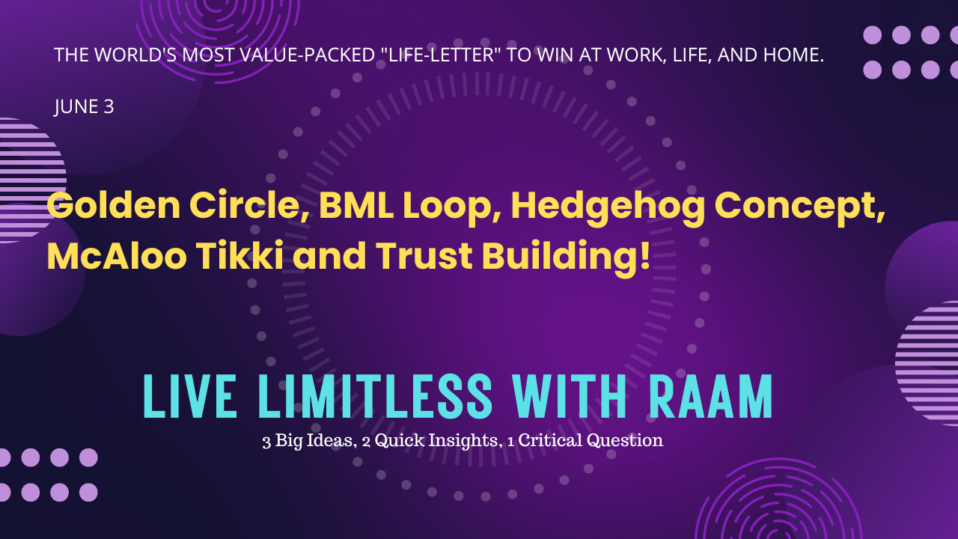Live Limitless with Raam
“The World’s Most Value-packed Newsletter Life-letter to WIN at Work, Life, and Home” with:
3 big ideas, tips or strategies
2 stories, quotes or case-studies
1 critical question to ask yourself
Live Limitless: Golden Circle, BML Loop, Hedgehog Concept, McAloo Tikki and Trust Building!
read on LIFELETTER.RAAMANAND.COM | JUNE 3, 2023
____________
3 Big Ideas, Tips or Strategies for this week
- Golden Circle
From the book “Start with Why” by Simon Sinek, we gain the ‘Golden Circle’ framework. It’s a model for inspirational leadership and effective communication, and it is structured around three elements:
WHY: This is your purpose or belief. Why does your organization exist? Why do you get out of bed in the morning? And why should anyone care?
HOW: These are the actions you take to realize your ‘Why’. How do you bring your cause to life?
WHAT: These are the results of those actions – the tangible things that you do or produce.
The key idea behind the Golden Circle is that transformative leaders and organizations communicate from the inside out. They start with the ‘Why’, then move to the ‘How’, and finally, the ‘What’. This pattern is designed to inspire others and drive action with purpose.
- Build-Measure-Learn
In the book “The Lean Startup” by Eric Ries, a new approach to business development is introduced, the “Build-Measure-Learn” feedback loop. This is a critical framework for startups and innovation development.
Build: Start by turning your idea into a product, service, or feature.
Measure: After the build process, the next step is to measure how customers respond. Use actionable metrics to assess your impact and progress.
Learn: Finally, learn from the data you’ve collected. Determine whether to pivot (make a fundamental change to the product or strategy) or persevere.
By focusing on this cycle, businesses can reduce waste, optimize productivity, and find a more direct path to meeting their customer and market needs.
- Hedgehog Concept
In “Good to Great” by Jim Collins, there’s a concept introduced known as the ‘Hedgehog Concept’. This is a model for identifying the intersecting areas where a company or individual can excel, and it’s composed of three circles:
What you are deeply passionate about: This circle represents the activities and goals that ignite your passion – things that you can feel enthusiastic about and can fully invest in.
What you can be the best in the world at: This circle represents your core competencies or unique abilities that you can do exceptionally well compared to others.
What drives your economic engine: This circle represents the key metrics that drive your economic success.
The intersection of these three circles is your ‘Hedgehog Concept’, representing the area where you should focus your efforts for maximum effectiveness and satisfaction.
_____________
2 Stories, Quotes, or Case-Studies for this week
1. McAloo Tikki
In the late 1980s, McDonald’s noticed a significant drop in their sales during the lunch hour rush in India. They discovered that a significant proportion of their customer base were vegetarians, who couldn’t eat the mainly meat-based menu. So, they decided to innovate and introduced the ‘McAloo Tikki’ burger, a completely vegetarian burger that included a potato and pea patty with Indian spices.
The response was overwhelming. The McAloo Tikki burger became one of the top-selling items in India, leading to a surge in their sales. McDonald’s then introduced a range of vegetarian food options in their menu across India.
The lesson from this incident is the importance of understanding your customer base and being willing to innovate and adapt to their needs. It’s also a great lesson on the value of cultural sensitivity in international business.
2. Building Trust
When eBay started, they didn’t have a feedback system for buyers and sellers. As the platform grew, so did the challenges. They faced issues with trust, as users were uncomfortable doing transactions with people they didn’t know or trust.
Pierre Omidyar, the founder of eBay, decided to introduce a feedback system where both buyers and sellers could rate each other after a transaction. This was a risky move, as it could have discouraged users from participating if they received negative feedback.
However, the opposite happened. The feedback system built trust within the eBay community and it became a significant factor in eBay’s growth. People felt more comfortable conducting transactions when they could see the feedback from previous interactions.
This story highlights the importance of trust in business relationships, and how sometimes, unconventional solutions can lead to great success.
_____________
1 Critical Question to Ask Yourself
Adaptability and trust-building are key to success, whether it’s by catering to unique customer needs or creating mechanisms to foster trust within your community. The question to ask yourself is: “Am I truly listening to the needs of my customers or community, and what innovative steps can I take today to better serve and build trust with them?”
Did you like this week’s “Life-letter”? Then, don’t keep this to yourself. Share it with others.
Share this life-letter on Twitter, Facebook, Linkedin, WhatsApp or via email.
Or, copy and paste the link below:
http://lifeletter.raamanand.com
Let’s meet again. Until then, Keep Smiling… Believe in Yourself… and Get all the Best Things in Life,
Raam Anand
Publishing Coach to hundreds of first-time authors around the world
Publisher & Chief Editor at Stardom Books (USA/India)
Author of the International Bestseller, Write Now


Post a comment